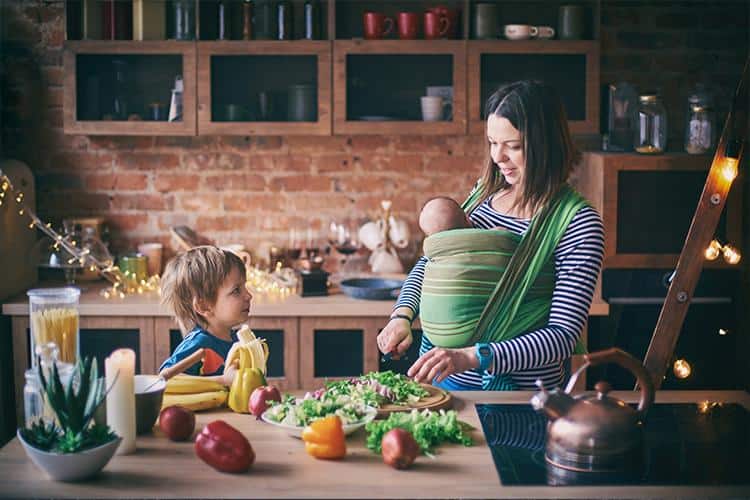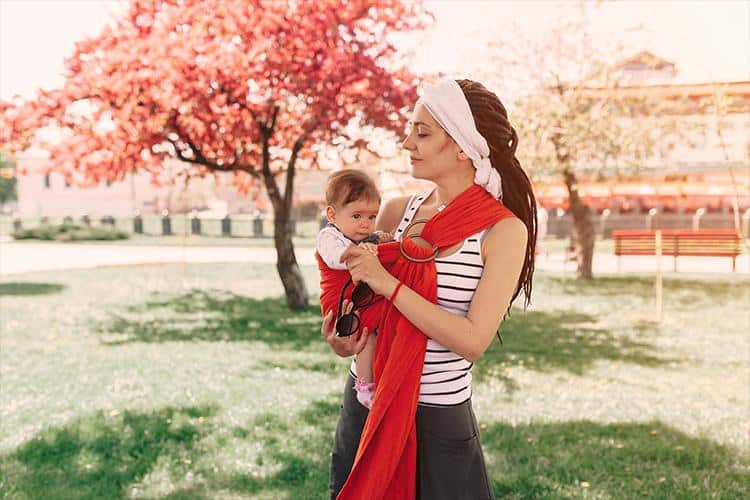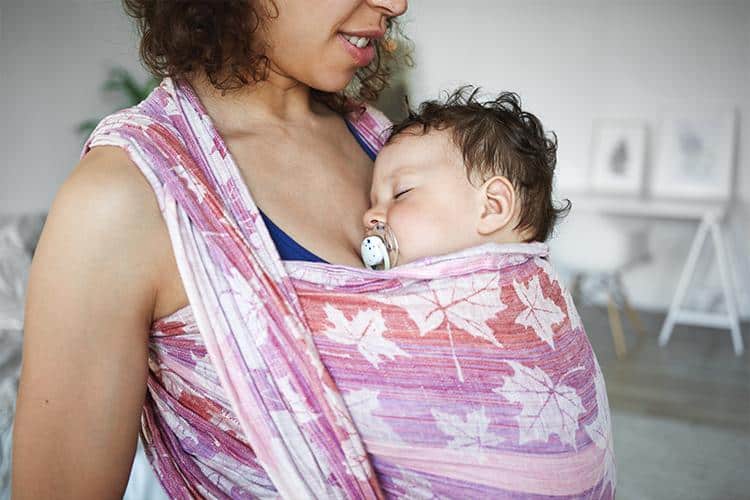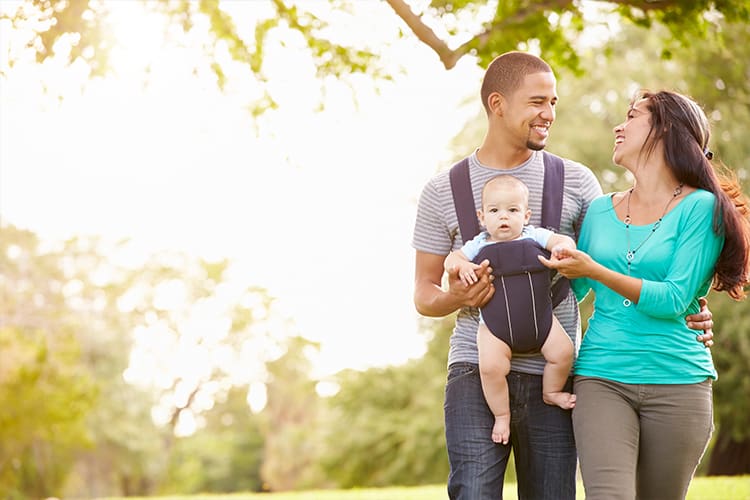Babywearing is a wonderful way to bond and enjoy the convenience of being hands-free while you carry your baby! Beyond connecting with your little one, there are even more benefits to safely babywearing, which we’ll discuss below. We’ll also talk about the different types of babywearing and whether or not you can breastfeed and babywear simultaneously. We will also cover some popular questions you may have before you begin babywearing.
What is Safe Babywearing?

Babywearing is the practice of carrying a baby or young child in a carrier, wrap, or sling close to your body. This method of transportation has been around for centuries and is still widely used today as it offers numerous benefits for both the caregiver and the child. Of course, there are correct and incorrect ways of babywearing. When babywearing, safety is the top priority. Always ensure your baby is upright, with their face visible and their airways clear. Use a carrier suitable for your child’s age and weight, and follow the manufacturer’s guidelines for proper use and positioning.
Keep a close eye on your baby’s body temperature and ensure they are not overheating, especially in hot weather. Lastly, always be mindful of your own movements and activities while babywearing, and avoid any actions that could potentially be dangerous for you or your baby. By following these safety measures, you can enjoy the benefits of babywearing while keeping your little one safe and secure.
5 Benefits of Baby Wearing

Babywearing offers numerous benefits for both the baby and the caregiver. Here are five benefits of safely wearing your baby:
Promotes bonding and attachment
Baby is able to be close to the caregiver while still having the opportunity to observe the world around them.
Helps regulate baby’s body temperature, heart rate, and breathing
Since baby is close to Mom or Dad, this helps with regulation.
Aids in the development of baby’s muscles and motor skills
Baby has the opportunity to move and adjust their position while being carried.
Offers hands-free convenience to parents
This makes it easier for Mom or Dad to complete daily tasks while keeping the baby close.
Helps to reduce the risk of postpartum depression and anxiety
Babywearing promotes feelings of closeness and security.
Overall, babywearing provides a practical and nurturing way for caregivers to meet their babies’ needs while also benefiting their own well-being. Plus, who doesn’t love those extra snuggles?
Different Types of Baby Carriers: Slings, Wraps, and More

Several different types of baby carriers are available, each designed to meet parents’ and caregivers’ unique needs and preferences. These include:
Soft structured carrier
Features padded shoulder straps and a waist belt for added support and comfort.
Ring sling
Offers a more adjustable and customizable fit for both the wearer and the baby.
Mei tai carrier
It provides a secure and cozy way to carry a baby, with wide straps that distribute the weight evenly across the wearer’s body.
Wrap carrier
Offers a simple yet versatile way to carry a baby, with various wrapping techniques to provide the desired level of support and security.
Ultimately, the best baby carrier for a parent will depend on their individual needs, lifestyle, and personal preferences.
Can You Wear Your Little One and Breastfeed Simultaneously?

It is absolutely possible to wear your little one in a carrier or wrap and breastfeed simultaneously. This method, often called “nursing in a carrier,” can be a great way to bond with your baby while keeping your hands free for other tasks. However, it’s important to ensure you and your baby are comfortable and properly positioned for breastfeeding while in the carrier. You may need to adjust the carrier or your baby’s position to find a comfortable and secure feeding position.
Additionally, be mindful of your baby’s head control and neck support while breastfeeding in a carrier to avoid any discomfort or strain. Moms can utilize carriers specifically designed for nursing, so it may be helpful to explore those options to find a style that works best for you and your little one.
FAQs: Benefits of Safe Babywearing
What is the safest way to wear a baby?
The safest way to wear a baby is to use a carrier or wrap designed specifically for carrying infants. Ensure you carefully read and follow the manufacturer’s safety tips to ensure the carrier is correctly used. Always ensure the baby’s airway is clear, and you can always see their face. It’s important to regularly check when wearing baby to ensure they are comfortable and secure. Additionally, it’s best to avoid activities that could jolt the baby while in the carrier, such as running or other high-impact exercises. You’ll want to ensure the carrier properly supports the baby’s spine and hips to avoid hip dysplasia.
Is baby-wearing safe for newborns?
When done properly, babywearing is considered safe for newborns. It allows for close physical contact between the caregiver and baby, which can promote bonding and development, regulate the baby’s body temperature, and provide a sense of security. However, it is important to follow safety guidelines and ensure that the baby’s airway is clear and unobstructed while being worn. It is also crucial to use a carrier that provides proper support so that the baby will have healthy hips. Keep your baby in view at all times when in the carrying position.
Is it OK to sit down while babywearing?
It is completely okay to sit down while babywearing as long as you do so safely and securely. When sitting down, it is important to ensure the baby is properly supported and their airways are clear. It is also important to ensure that the baby carrier or wrap is properly adjusted and fastened to provide proper support for you and your baby. Sitting down while babywearing provides comfort and cuddles for your little one while giving yourself a break from standing and walking. Whether you are sitting to feed your baby, relax, or simply take a break, it is important to be mindful of your posture and your baby’s position to ensure both your safety and comfort.
Is it OK to baby wear all day?
It is absolutely okay for the baby all day as long as both the parent and the baby are comfortable and safe. Babywearing has been shown to have numerous benefits for both the parent and the child, including fostering a strong bond, promoting healthy development, and allowing for ease of mobility throughout the day. However, it is important to listen to your body and take breaks when necessary, as carrying a baby for extended periods of time can be physically demanding. It is also crucial to ensure the baby is positioned correctly in the carrier to prevent discomfort or potential injury. Additionally, it is important to vary the positions in which the baby is carried to avoid putting strain on specific body areas.
Is babywearing good for development?
Babywearing can be a wonderful way to promote development in infants. The close physical contact that comes with baby-wearing can promote a strong sense of security and attachment, which are crucial for healthy emotional development. Additionally, the gentle swaying and movement that happens while being worn can help to improve a baby’s balance and coordination. The constant exposure to the caregiver’s movements and activities can also stimulate the baby’s senses and promote cognitive development. Moreover, babies who are worn often tend to cry less, possibly due to feeling more secure and comforted by the close physical contact. However, using a proper baby carrier is important to ensure the infant’s safety. While baby-wearing can offer numerous benefits for a baby’s development, it’s important always to be mindful of the baby’s comfort and safety.
Does baby wearing make babies clingy?
Babywearing is a beautiful way for caregivers to meet their infants’ needs for closeness and security. Despite common beliefs, research suggests that baby wearing does not make babies clingy. In fact, the close physical contact and secure feeling that comes from being carried in a sling or carrier can promote children’s independence by providing a secure base from which to explore the world around them. Keeping your baby close can also aid in developing a secure attachment between the caregiver and the baby, which has been linked to positive social and emotional development in children. It’s important to remember that every baby is different, and their temperament and personality can greatly influence how they respond to being carried.
Conclusion
Whether choosing a carrier, sling, or wrap, babywearing is beneficial as long as it’s being done safely. You should learn how to use your carrier appropriately and be able to see your baby’s face at all times. Proper support is important for healthy hip development as baby grows. Additionally, babywearing allows for bonding between caregiver and baby, as well as convenience and freedom of movement for the caregiver. It can also provide a soothing and comforting environment for the baby, as they are close to the caregiver’s heartbeat and can hear their voice.

Morgan French is a wife, mom of two, writer & editor. After traveling for 3 years with her family, she now lives back in her hometown of Dayton, OH. She makes frequent stops for coffee, enjoys the outdoors, and loves board games.



Leave A Comment